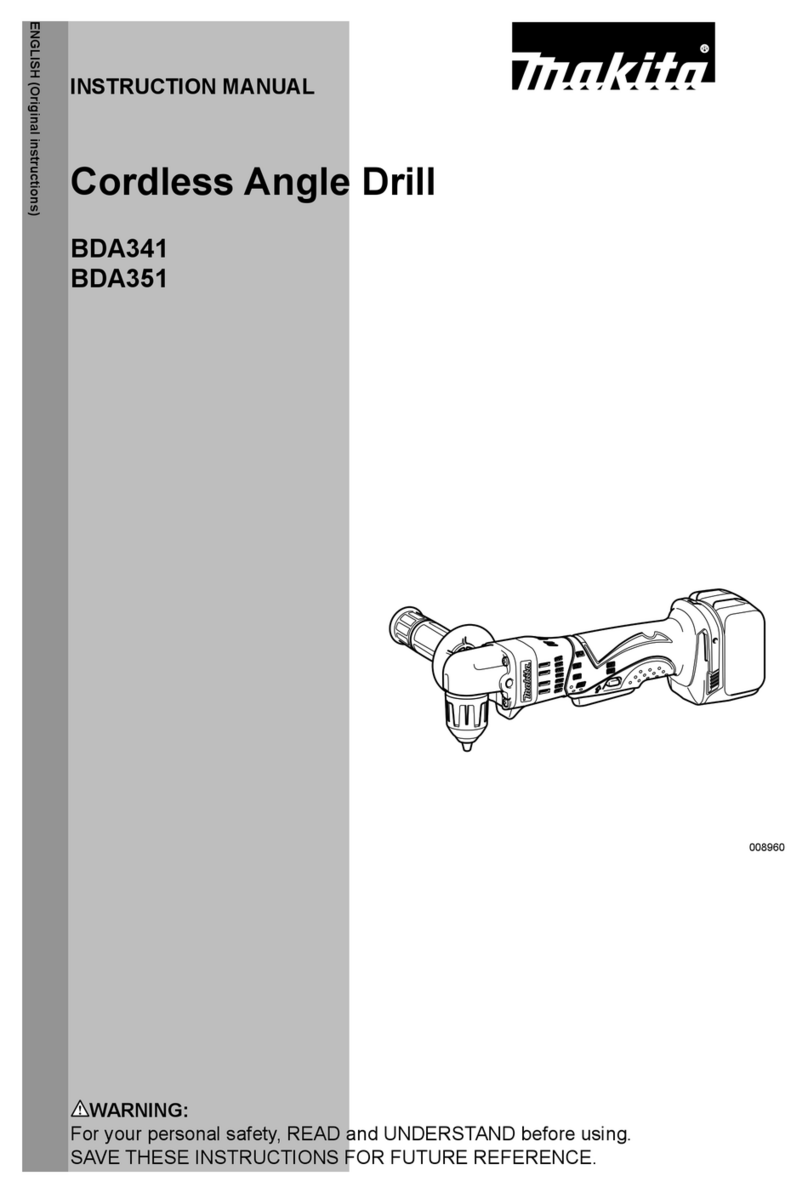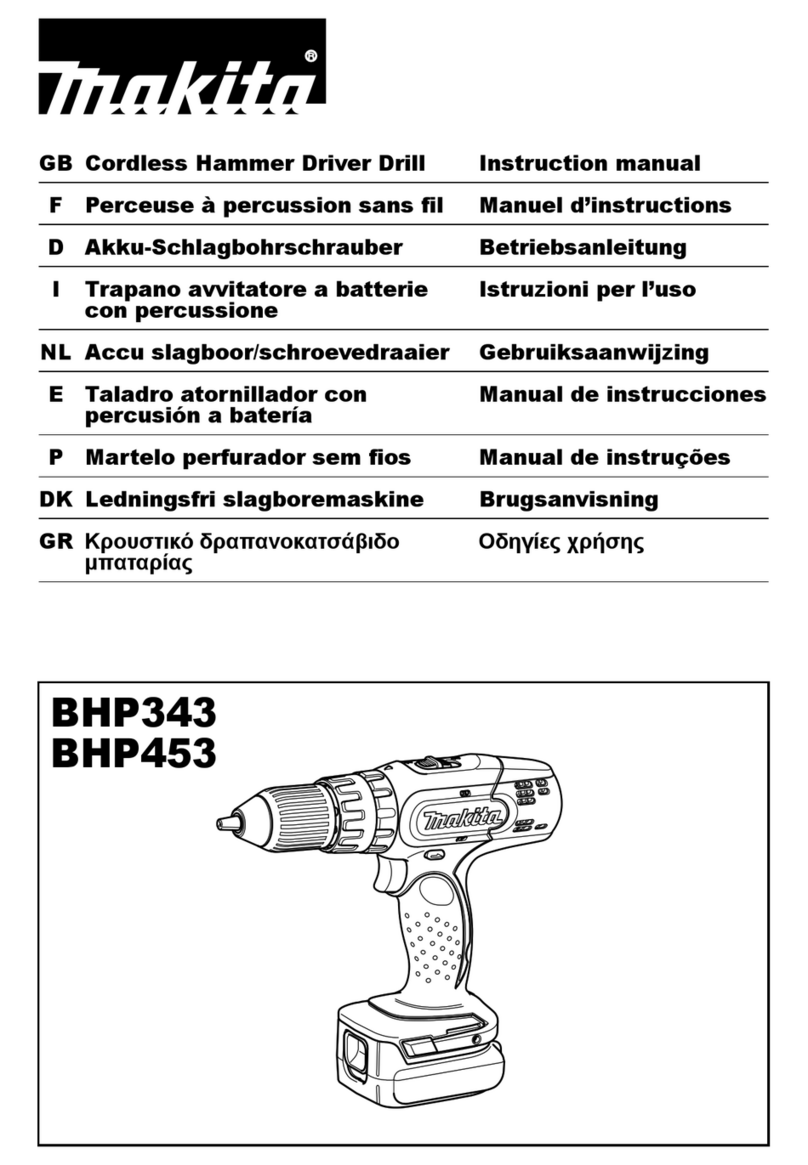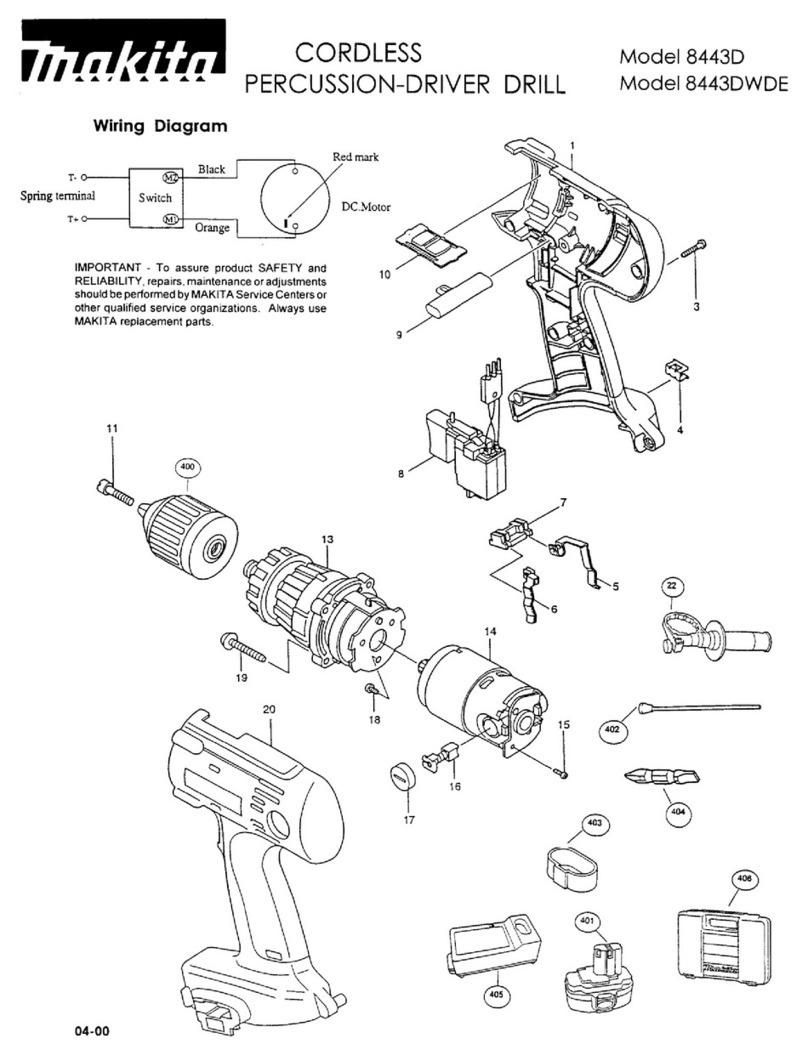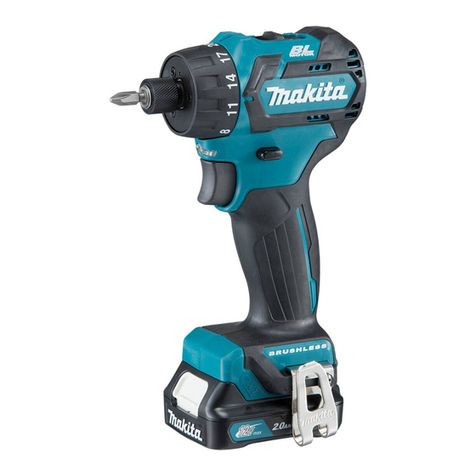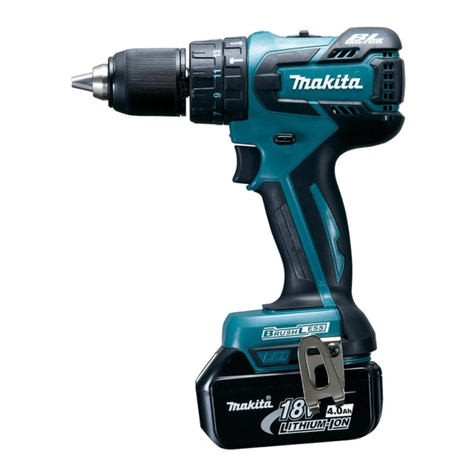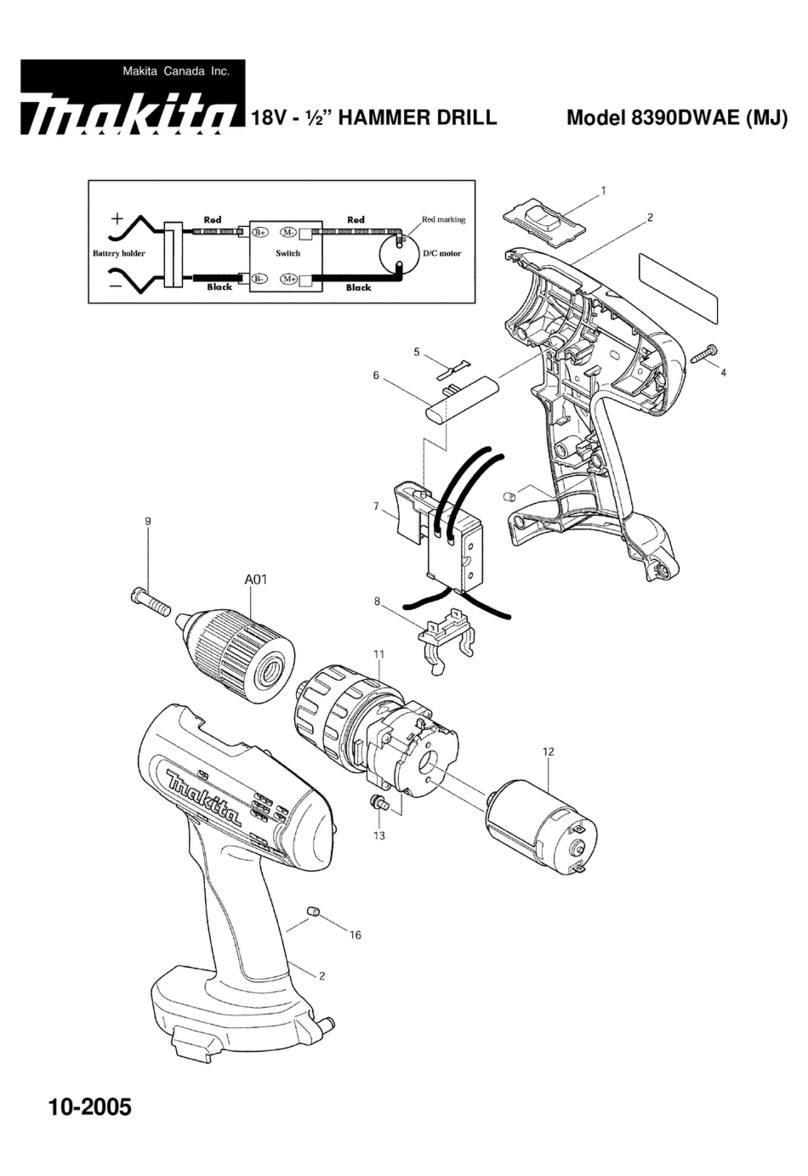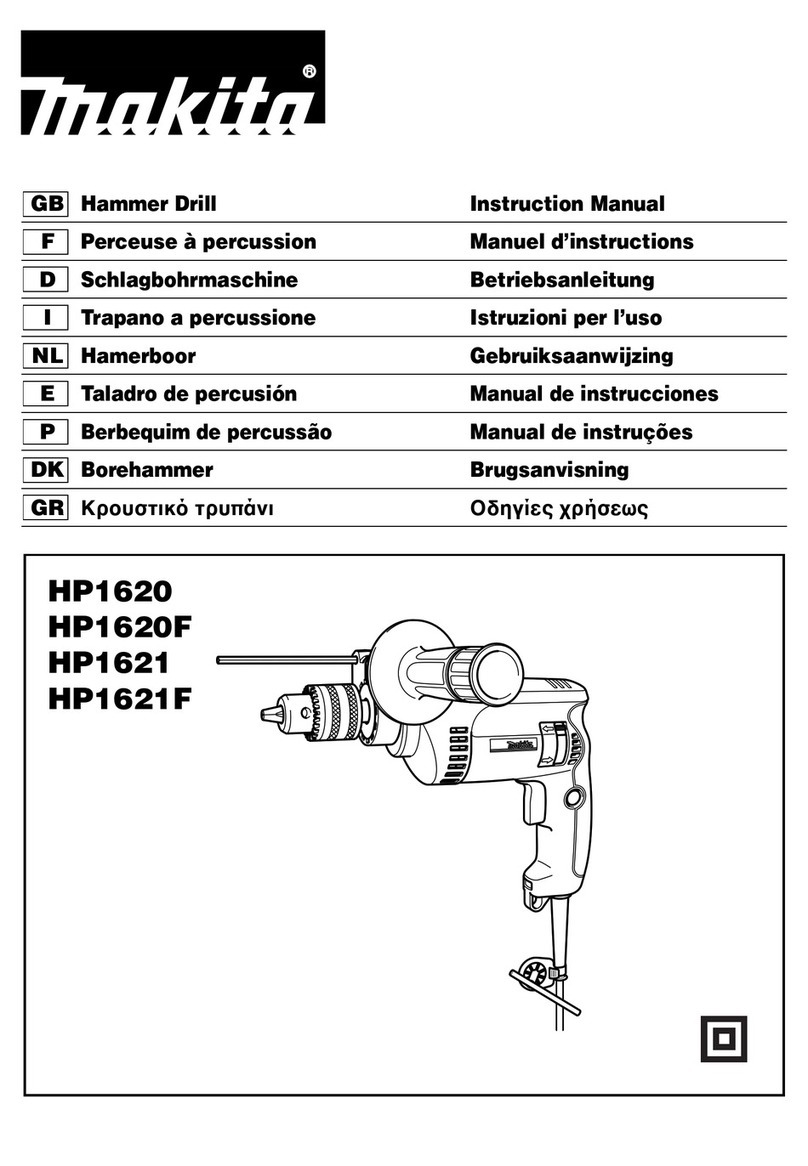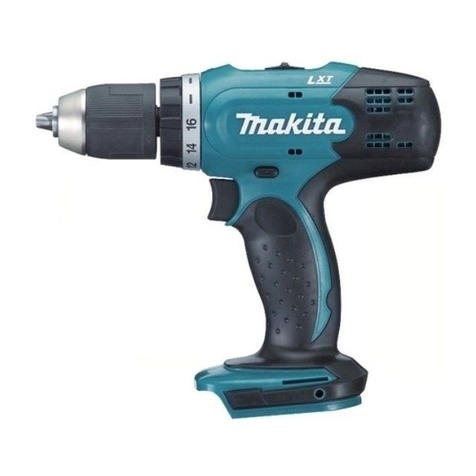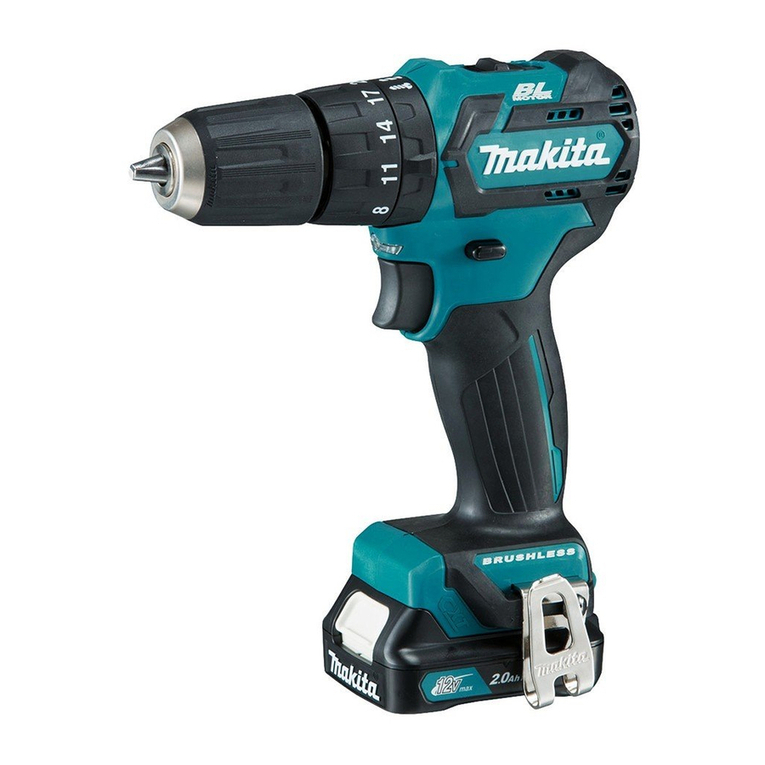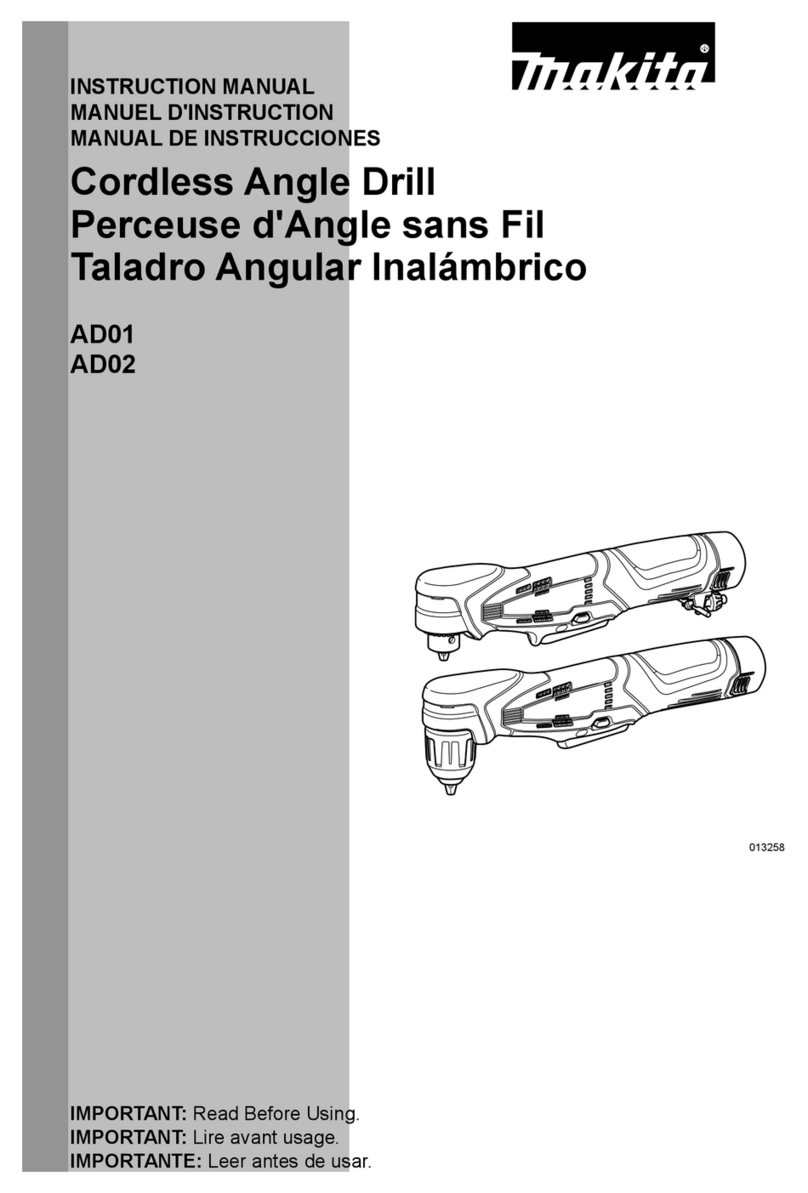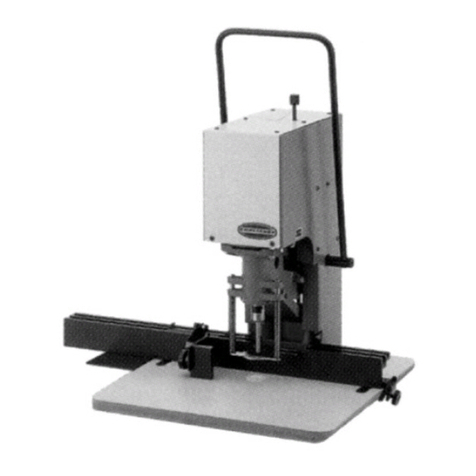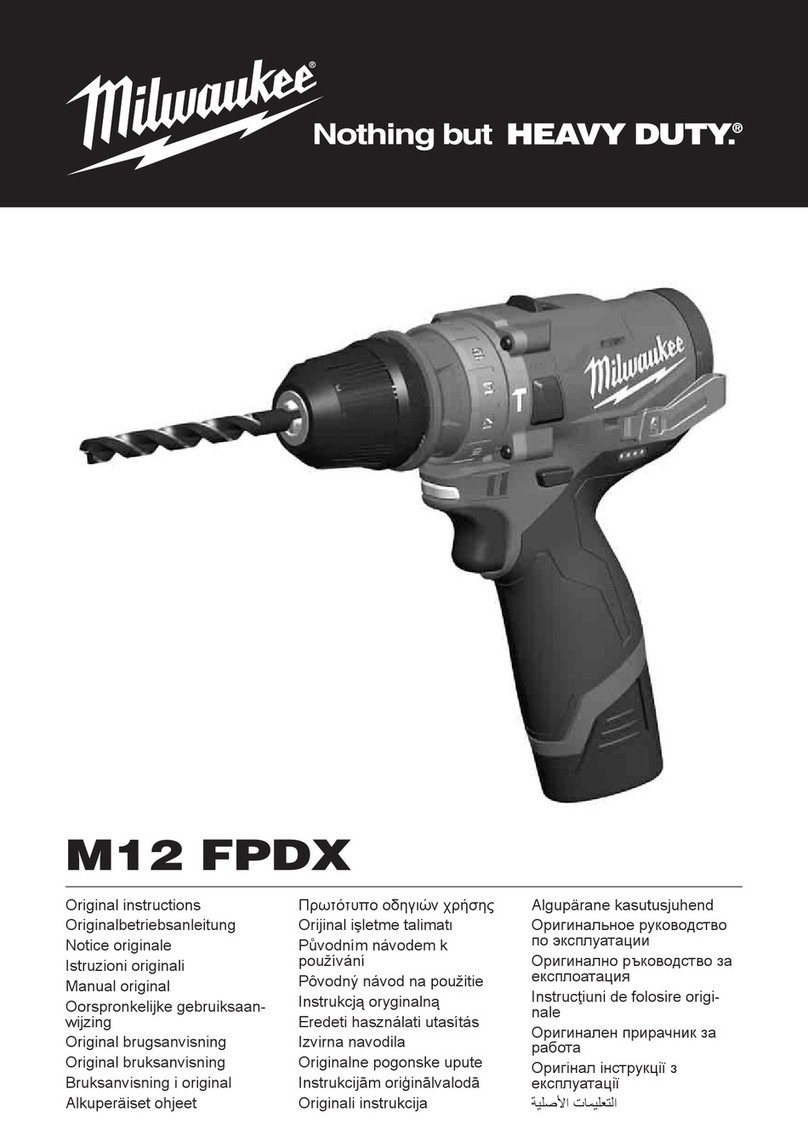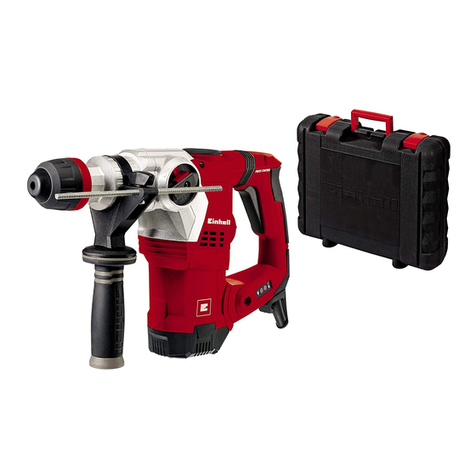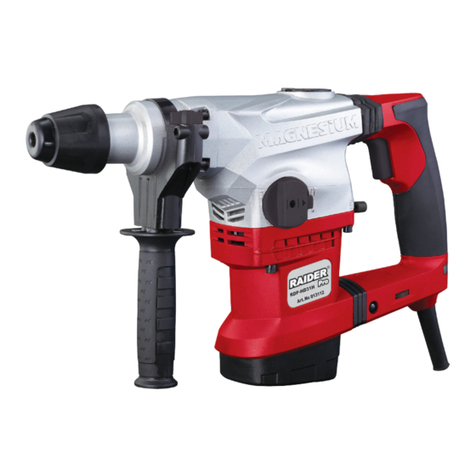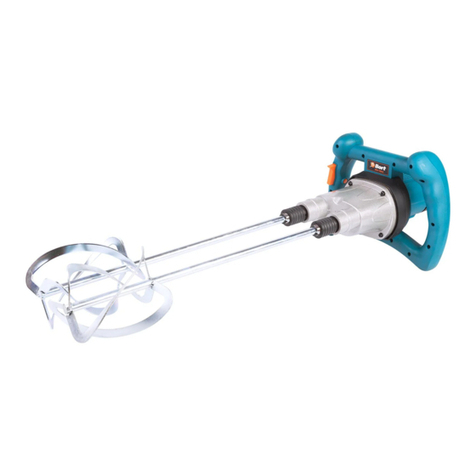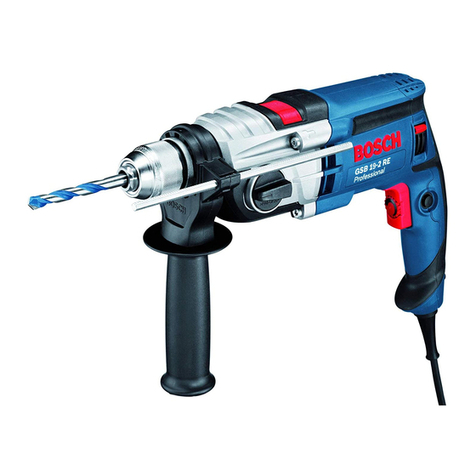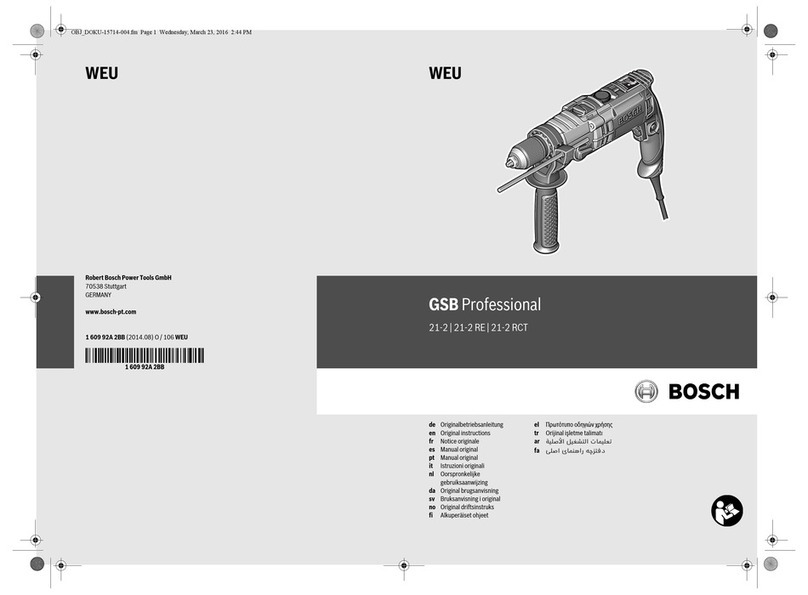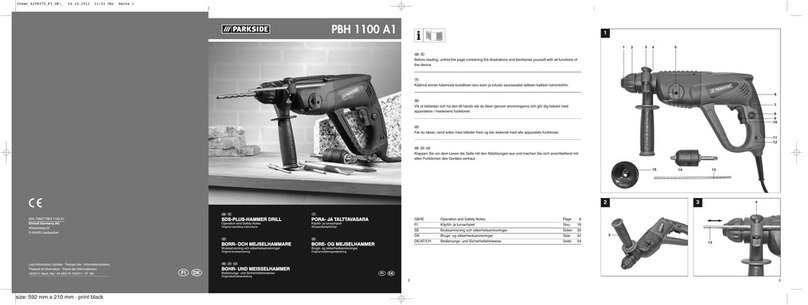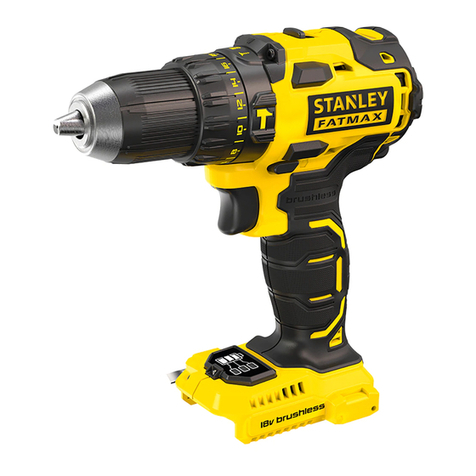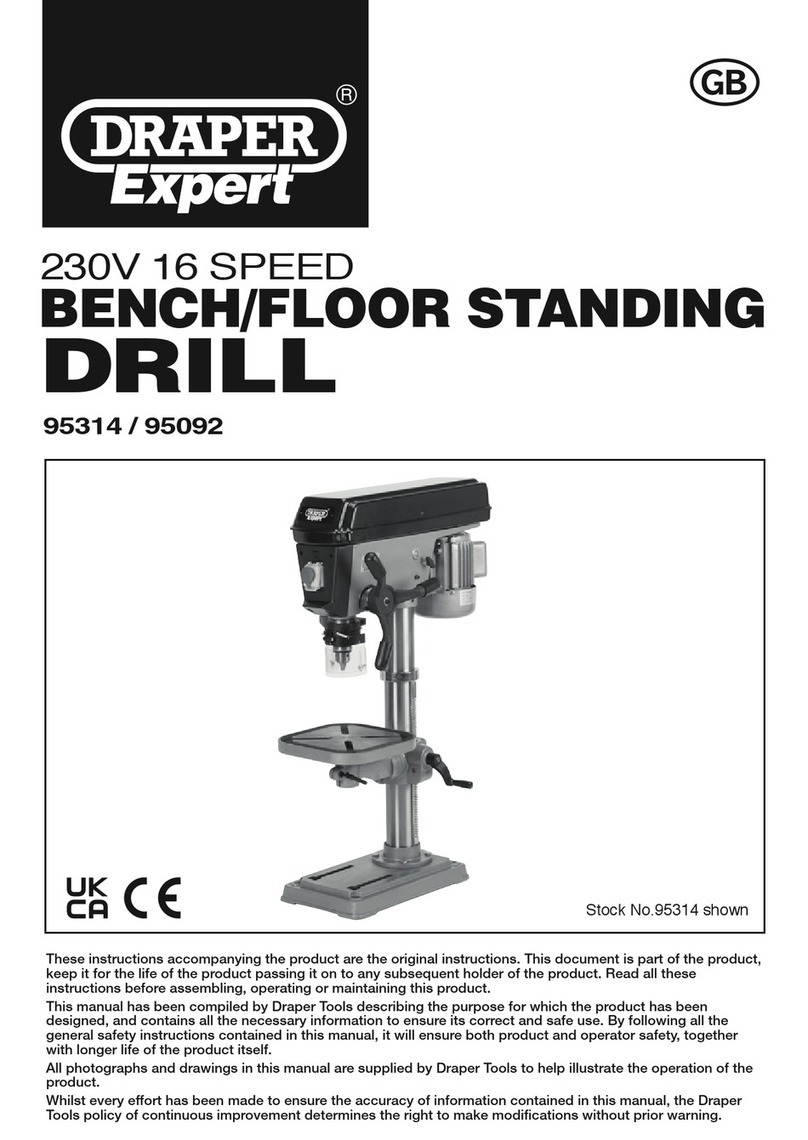
18
8. Raak de boor of het werkstuk niet aan onmiddel-
lijk na het gebruik; deze kunnen erg heet zijn en
brandwonden veroorzaken.
BEWAAR DEZE VOORSCHRIFTEN.
BEDIENINGSVOORSCHRIFTEN
Installeren of verwijderen van de accu (Fig. 1)
• Schakel het gereedschap altijd uit alvorens de accu te
installeren of te verwijderen.
• Om de accu te verwijderen, neemt u deze uit het
gereedschap terwijl u de knop op de zijkant van de
accu verschuift.
• Om de accu te installeren, doet u de tong op de accu
overeenkomen met de groef in de behuizing en dan
schuift u de accu erin. Schuif de accu zo ver mogelijk
erin totdat deze op zijn plaats vastklikt. Wanneer het
rode gedeelte op de bovenkant van de knop nog zicht-
baar is, zit de accu niet volledig erin. Schuif hem volle-
dig erin totdat het rode gedeelte niet meer zichtbaar is.
Als u dit niet doet, kan de accu per ongeluk eruit vallen
en uzelf of andere personen in uw omgeving verwon-
den.
• Probeer niet de accu met geweld in het accuhuis te
duwen. Indien de accu niet gemakkelijk erin gaat, bete-
kent dit dat u hem niet op de juiste wijze erin steekt.
Zijhandgreep (hulphandgreep) (Fig. 2)
Gebruik altijd de zijhandgreep om een veilige bediening
te verzekeren. Monteer de zijhandgreep zodanig dat zijn
tanden tussen de uitsteeksels op de schacht van het
gereedschap passen. Zet daarna de handgreep vast
door deze rechtsom naar de gewenste positie te draaien.
De zijhandgreep is 360° draaibaar zodat u deze in elke
gewenste positie kunt gebruiken.
Afstelbare dieptestang (Fig. 3)
De afstelbare dieptestang wordt gebruikt om gaten van
gelijke diepte te boren. Draai de vleugelschroef los, zet
de stang in de gewenste positie, en draai de vleugel-
schroef weer vast.
Installeren of verwijderen van schroefbit of boor
(Fig. 4 en 5)
Belangrijk:
Controleer altijd of het gereedschap is uitgeschakeld en
de accu ervan is verwijderd alvorens de boor te installe-
ren of te verwijderen.
Draai de bus naar links om de klauwen van de boorkop te
openen. Steek de boor zo diep mogelijk in de boorkop.
Draai daarna de bus naar rechts om de boorkop vast te
zetten.
Om de boor te verwijderen, draai de bus naar links.
Plaats de boor in de boorhouder wanneer u deze niet
gebruikt. In de boorhouder kunt u boren met een lengte
van maximaal 45 mm plaatsen.
Werking van de trekschakelaar (Fig. 6)
LET OP:
Alvorens de accu in het gereedschap te plaatsen, moet u
altijd controleren of de trekschakelaar juist werkt en bij
het loslaten naar de “OFF” positie terugkeert.
Om het gereedschap in te schakelen, drukt u gewoon de
trekschakelaar in. Hoe dieper de trekschakelaar wordt
ingedrukt, hoe sneller het gereedschap draait. Om het
gereedschap uit te schakelen, de trekschakelaar losla-
ten.
Werking van de omkeerschakelaar (Fig. 7)
LET OP:
• Controleer altijd de draairichting alvorens het gereed-
schap te gebruiken.
• Verander de stand van de omkeerschakelaar alleen
nadat het gereedschap volledig tot stilstand is geko-
men. Indien u de draairichting verandert terwijl de boor
nog draait, kan het gereedschap beschadigd raken.
• Zet de omkeerschakelaar altijd in de neutrale stand
wanneer het gereedschap niet wordt gebruikt.
Dit gereedschap heeft een omkeerschakelaar voor het
veranderen van de draairichting. Druk de omkeerschake-
laar in vanaf zijde A voor rechtse draairichting, of vanaf
zijde B voor linkse draairichting. Wanneer deze schake-
laar in de neutrale stand staat, kan de trekschakelaar niet
worden ingedrukt.
Veranderen van het toerental (Fig. 8)
Om het toerental te veranderen, schakelt u eerst het
gereedschap uit en dan schuift u de toerentalschakelaar
naar de “II” zijde voor hoog toerental, of naar de “I” zijde
voor laag toerental. Zorg ervoor dat de toerentalschake-
laar in de juiste stand staat alvorens met het werk te
beginnen. Gebruik het toerental dat geschikt is voor uw
werk.
LET OP:
• Schuif de toerentalschakelaar altijd volledig naar de
juiste positie. Als u het gereedschap gebruikt met de
toerentalschakelaar halverwege tussen de “I” en “II”
posities, kan het gereedschap beschadigd raken.
• Verschuif de toerentalschakelaar niet terwijl het
gereedschap draait. Hierdoor kan het gereedschap
beschadigd raken.
Instellen van het draaimoment (Fig. 9)
Het draaimoment kan worden ingesteld in 17 stappen
door de stelring zodanig te draaien dat zijn schaalverde-
lingen overeenkomen met de wijzer op het huis van het
gereedschap. Het draaimoment is minimaal wanneer het
cijfer 1 met de wijzer overeenkomt, en is maximaal wan-
neer de Amarkering met de wijzer overeenkomt.
Wanneer de stelring op een cijfer van 1 tot 16 is inge-
steld, zal de koppeling bij verschillende draaimomentni-
veau’s slippen. De koppeling is ontworpen om niet te
slippen bij de Amarkering.
Alvorens met het eigenlijke werk te beginnen, moet u het
geschikte draaimoment bepalen door een proefschroef in
uw werkstuk of in een ander stuk van hetzelfde materiaal
te schroeven.
OPMERKING:
• De stelring vergrendelt niet wanneer de wijzer halfweg
tussen de schaalverdelingen staat.
• Gebruik het gereedschap niet met de stelring ingesteld
tussen het cijfer 16 en de Amarkering. Hierdoor kan het
gereedschap beschadigd raken.
